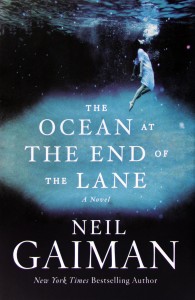 Neil Gaiman’s most recent novel, “The Ocean at the End of the Lane,” explores how it really felt to be a child: not the wonder and joy of becoming a wizard, but the overwhelming fear of the world around you. The world doesn’t make sense to children; they fear the unknown, and everything is unknown.
Neil Gaiman’s most recent novel, “The Ocean at the End of the Lane,” explores how it really felt to be a child: not the wonder and joy of becoming a wizard, but the overwhelming fear of the world around you. The world doesn’t make sense to children; they fear the unknown, and everything is unknown.
The novel starts when the unnamed narrator returns to his childhood home in Sussex, England following a funeral. Through random circumstance, he ends up at the house at the end of the lane, where he knew a girl a few years older than him named Lettie Hempstock. The closer he gets to the Hempstock household, the more he begins to remember about his childhood: the narrator paints the picture of a seven-year-old boy made anxious by the entire world, who had no friends and only knew how to act based on the books he’d read. He would climb trees because boys in books climbed trees, even though climbing trees terrified him. It isn’t until the narrator reaches the duck pond at the back of the Hempstock residence that he remembers everything.
The narrator met Lettie Hempstock the day a man lodging at his home — an opal miner — stole his dad’s car, drove to the end of the lane and rigged the car to fill with exhaust while he was still inside. This suicide draws the attention of ancient beings with the power to change the world however they see fit, including the antagonist Ursula Monkton, a nanny who appears as either a beautiful grey-eyed woman or a monstrous entity with limbs like broken mainsails and face like rotted cloth.
Ursula Monkton insinuates herself into the narrator’s family, and he is the only one who can see her as the monster she is. His only hope for salvation lies with the benevolent Hempstocks, who seem to have just as strange powers.
“The Ocean at the End of the Lane” seems like a children’s story on the surface — we have a child protagonist, horrible villains only a child can see and a kind of moony logic that makes sense only to a child — but the actual nature of the story is very, very, adult oriented. Gaiman has a habit of looking at adult concepts from the filter of childhood: infidelity, for example, means one thing to an adult, but think about how that looks to a seven-year-old boy. He doesn’t understand what it means when dad has hiked the nanny’s skirt up, but he knows there is something very wrong with how he’s kissing her neck: it’s a piece of data with no corollary, nothing to compare it to. He can only base ideas off of imperfect knowledge. This is best exemplified when the narrator mentions visiting a wax museum. He had expected to see movie monsters, but was instead subject to wax reproductions of gruesome murderers in the act.
“Most of them were depicted with their victims in awkward social situations, seated around a dinner table perhaps, as their poisoned family members expired. The plaques that explained who they were also told me that the majority of them had murdered their families and sold the families to anatomy. It was then that the word ‘anatomy’ garnered its own edge of horror for me. I did not know what anatomy was. I knew only that anatomy made people kill their children.”
The boy isn’t afraid of death, he’s afraid of anatomy. It’s not the sex that scares the boy, it’s the kiss: the sign, not the signifier. This kind of fear highlights the real helplessness that flows throughout Gaiman’s novella. He is a master at getting the reader to live in a child’s head and accept the sort of leap of logic a seven-year-old would make. It’s this ability to make an inherently irrational idea rational that makes “The Ocean at the End of the Lane” so satisfying: you know a duckpond can’t be an ocean, but you believe it is anyway because you were told it was.
I would recommend this book to anyone who enjoys darker stories about childhood, or is a fan of weird fiction: there is a touch of the Lovecraftian in the monsters that live in this book. In a way, Gaiman’s child protagonist is a mirror of the standard H.P. Lovecraft hero: a bookish sort who goes up against something that he cannot understand, that by its very nature will drive him insane. Except with the protagonist in “The Ocean at the End of the Lane,” the mind-bending horror is the adult world: the monster makes more sense to him than anything else.
“I saw the world I had walked since my birth and I understood how fragile it was, that the reality I knew was a thin layer of icing on a great dark birthday cake writhing with grubs and nightmares and hunger.”











